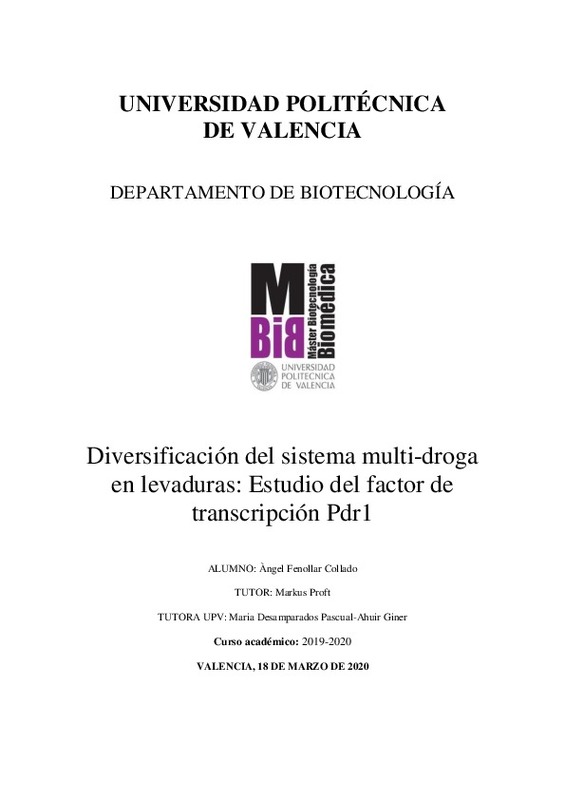|
Resumen:
|
[ES] Los organismos eucariotas, desde hongos hasta humanos, poseen sistemas de transducción de señales para responder y adaptarse a una gran variedad de moléculas xenobióticas. La activación de estos sistemas multidrug ...[+]
[ES] Los organismos eucariotas, desde hongos hasta humanos, poseen sistemas de transducción de señales para responder y adaptarse a una gran variedad de moléculas xenobióticas. La activación de estos sistemas multidrug es una causa importante de la resistencia pleiotrópica a los compuestos antifúngicos en hongos patógenos, así como a los tratamientos contra el cáncer en las células humanas. Aquí investigamos la diversidad natural de la respuesta multidrug , que se produce en aislados naturales evolucionados de manera diferente de la levadura Saccharomyces cerevisiae. En este organismo, Pdr1 es el principal activador transcripcional, que reconoce directamente los xenobióticos y, posteriormente, activa la expresión de genes que codifican los transportadores de eflujo de fármacos, lo que genera resistencia al xenobiótico. En este trabajo, diferentes variantes de Pdr1 de diversas cepas naturales de S. cerevisae y de la levadura patógena Candida glabrata se fusionarán con el dominio de unión al ADN de Gal4. La capacidad de activación de estas proteínas de fusión Pdr1 se analizará en células de levadura mediante ensayos de luciferasa de células vivas en respuesta a concentraciones crecientes de xenobióticos (por ejemplo, menadiona). Esto permitirá comparar las sensibilidades de las diferentes variantes de Pdr1. Los datos obtenidos se compararán con las sensibilidades relativas de las diferentes cepas de levadura a las concentraciones de menadiona y otros xenobióticos que inhiben el crecimiento. En ensayos complementarios, los aislamientos naturales de S. cerevisiae, que han evolucionado en diferentes hábitats, se transformarán con reporteros de células vivas específicos para la respuesta PDR. Las diferentes cepas se examinarán para determinar su activación dependiente de la dosis de la respuesta multidrug mediante ensayos de luciferasa y para determinar su resistencia a xenobióticos mediante ensayos de crecimiento continuo. Tomados en conjunto, los resultados permitirán cuantificar la diversidad natural de los sistemas multidrug de levadura y específicamente de Pdr1, y comparar estos comportamientos con la resistencia xenobiótica de las cepas respectivas.
[-]
[EN] Eukaryotic organisms, from fungi to humans, possess signal transduction systems to respond and adapt to a great variety of xenobiotic molecules. Activation of these multidrug systems is a major cause of pleiotropic ...[+]
[EN] Eukaryotic organisms, from fungi to humans, possess signal transduction systems to respond and adapt to a great variety of xenobiotic molecules. Activation of these multidrug systems is a major cause of pleiotropic resistance to antifungal compounds in pathogenic fungi as well as to anticancer treatments in human cells. Here we investigate the natural diversity of a multidrug response, which occurs in differentially evolved natural isolates of the yeast Saccharomyces cerevisiae. In this organism, Pdr1 is the main transcriptional activator, which directly recognizes xenobiotics and subsequently activates the expression of genes encoding drug efflux transporters, thus leading to resistance to the xenobiotic. In this work, different Pdr1 variants from diverse natural S. cerevisae strains and from the pathogenic yeast Candida glabrata will be fused to the Gal4 DNA-binding domain. The activation capacity of these Pdr1 fusion proteins will be assayed in yeast cells by live cell luciferase assays in response to increasing concentrations of xenobiotics (for example menadione). This will allow to compare the sensitivities of the different Pdr1 variants. The obtained data will be compared with the relative sensitivities of the different yeast strains to growth inhibiting concentrations of menadione and other xenobiotics. In complementary assays, natural S. cerevisiae isolates, which have evolved in different habitats, will be transformed with live cell reporters specific for the PDR response. The different strains will be examined for their dose-dependent activation of the multidrug response by luciferase assays and for their xenobiotic resistance by continuous growth assays. Taken together, the results will allow to quantify natural diversity of yeast multidrug systems and specifically of Pdr1, and to compare these behaviors with the xenobiotic resistance of the respective strains.
[-]
|







